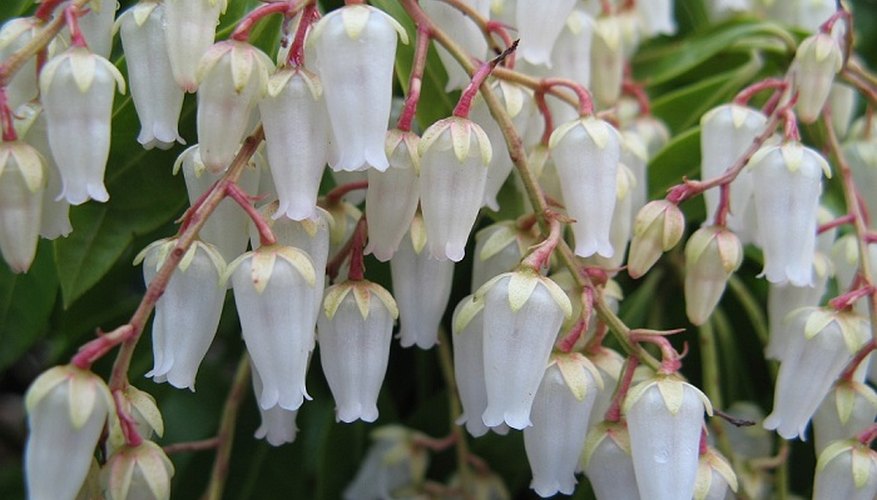Pieris japonica is a tough but graceful broadleaved evergreen that is well suited to the temperate UK and climate, prospering even in colder northern parts of the country. The bush emerges each spring to illuminate gardens with branch-obscuring clusters of fragrant Lily of the Valley like blooms. The delicate white flowers glow against Pieris' young bronze foliage. The tapering oblong leaves mature to dark lustrous green. Pieris thrives in well-drained, fertile acidic soils and full sun or partial shade. It propagates readily from cuttings.
Remove a cutting from a healthy Pieris plant in the summer, when it has just completed a burst of growth. Cuttings taken from broadleaved evergreens like Pieris have a greater chance of rooting successfully if they come from partially matured wood.
- Pieris japonica is a tough but graceful broadleaved evergreen that is well suited to the temperate UK and climate, prospering even in colder northern parts of the country.
- Cuttings taken from broadleaved evergreens like Pieris have a greater chance of rooting successfully if they come from partially matured wood.
Examine the shrub for a healthy branch with pest- and disease-free leaves. Measure 10 cm to 20 cm from its growing tip. Use the knife to trim off your cutting.
- Examine the shrub for a healthy branch with pest- and disease-free leaves.
Strip the foliage from the 1 cm to 2.5 cm of the cutting with the knife. Decaying leaves encourage bacteria in the rooting medium.
Cover a flat surface with waxed paper. Sprinkle the paper with rooting hormone. Grasp the cutting in one hand, holding it upright. Pass the lower end through the rooting hormone until the powder coats the cut surface.
Add rooting medium to one of the containers. Use one of the florist's green sticks to hollow out a hole in the pot's centre. Make the hole is wide enough to avoid scraping the rooting powder from the inserted cutting. Set the medium from the hole aside.
Insert the cutting into the hole so that the rooting medium contacts the hormone-coated surface. Pack the reserved medium around the cutting's base, securing it firmly in position. Add enough water to remove air pockets and settle the rooting medium.
- Add rooting medium to one of the containers.
- Insert the cutting into the hole so that the rooting medium contacts the hormone-coated surface.
Measure the cutting's height. Use the knife to cut three of the green sticks so they are 5 cm taller than the cutting. Insert the cut sticks in the medium, spacing them evenly around the container's lip.
Drape the clear plastic over the tops of the sticks. Secure it around the lip of the container with the rubber band to create a temporary greenhouse.
Lift the plastic daily to spritz the top of the cutting and moisten the medium with water from the syringe. Remove leaf debris. Give the cutting a slight tug to test for resistance, the indication of root formation. Pieris cuttings typically root in six to eight weeks.
- Measure the cutting's height.
- Give the cutting a slight tug to test for resistance, the indication of root formation.
Repot the cutting in a container filled with potting soil when it has grown two or three 1 cm roots. Use the fork to perforate the clear plastic with several holes before replacing it over the cutting. By releasing moisture gradually, the holes let the cutting adapt to a less humid environment.
Remove the plastic permanently after a week. Place the cutting outdoors in an area sheltered from direct sun and severe temperatures. Wait several weeks for your Pieris to acclimatise to the outdoors before you plant it.
